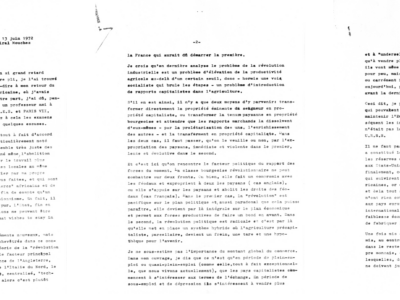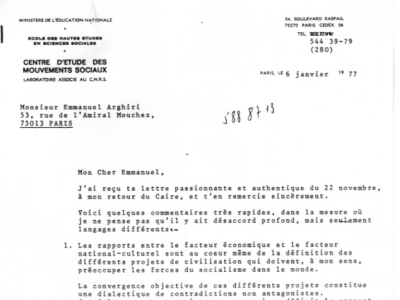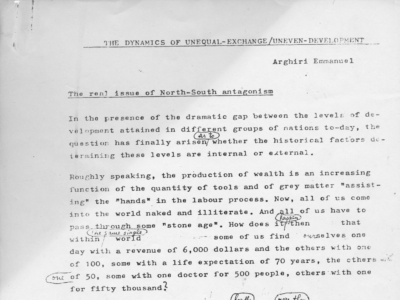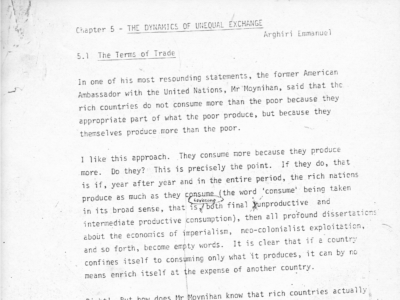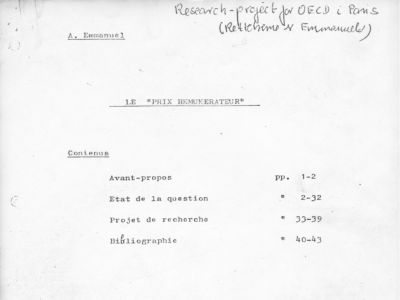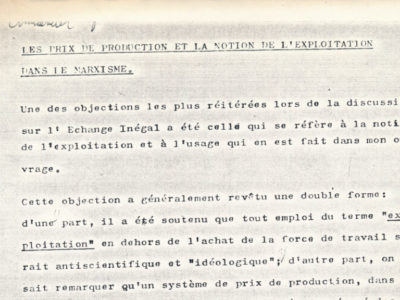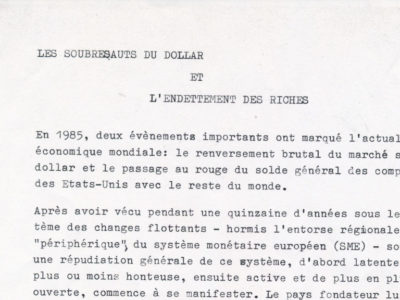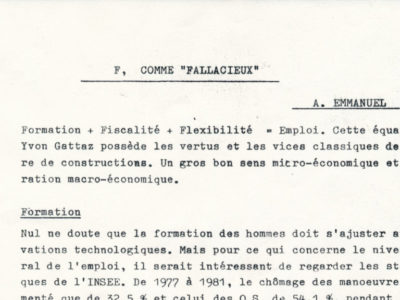Download as PDF.
In my paper, I put the question whether the wage is an input, like any other input, or a distribution variable, like rent or interest. Now, all that is of course a matter of definition, because the same question can be put otherwise: is the labour power and the wage resp. a commodity and a price, like any other commodity and any other price, or do they belong to the special category of those commodities and prices, which, for one reason or another, (monopoly, discontinuity in the reproduction possibilities etc.) are escaping the yoke of the law of value? We can further ask whether this is intrinsically or only historically so.
Marx did not at all put these questions. He took it as granted that the labour power is a plain commodity which, like any other commodity, ought to be exchanged according to its value, and then strived to answer the question, left unanswered by Smith and Ricardo, how and where the generation of the surplus could take place in a world of commodities where all commodities, including the labour power, are being exchanged at their values.
We must admit from the outset that, even if we abstract from all contingencies of the real world and from all peculiarities, that is, even if we stand on the highest theoretical level, however artificial it may be and accept Marx’s analysis on its own terms, this will eventually not give us the value of the would-be commodity which constitutes our problem, that is of the labour power, but the value of the labourer, that is the cost of an imaginary breeding of a special sort, the breeding of human beings making up the working class.
Now, if the worker was hired to an employer at a lump sum for his whole lifetime, this would be of no importance. But the wage-labour contract is a time contract, that is the quantity of labour power sold is expressed in units of time. So, to derive the value of the labour power from the cost of production of the labourer we would need to know the quantity of labour likely to be supplied by each one of them, since there is no proportionality between the cost of their breeding and either the length of the working day or the length of the active life.
Marx did not deal with the latter but he went well through the former in the 10th chapter of the first book of CAPITAL, as an integral of his theory on the determination of the value of the labour power, stating from the outset that this quantity is an exogenous one. T̈he establishment of a normal working day is the result of a struggle of several centuries between the capitalist and the worker,̈ and admitting that äpart some limits, on the whole very elastic, the very nature of the exchange of commodities prescribes no limitation to the working day and to the surplus labour.̈
Now, this is absolutely contradictory to the idea that the value of the labour power is measured like that of any other commodity by the labour time socially necessary to produce it. It is the same as if we said that the value and price of the loaf is perfectly determined by endogenous forces although it is only an exogenous legislative act which will decide whether the loaf will be of 1 lb. or 4 lb. weight.
But even if we took as constant the length of the working day and of the active life, according to the position of Ricardo, strongly objected by Marx, in other words, even if we decided to deal only with the cost of reproduction of the worker himself, irrespective of the quantity of the labour power we can siphon out of him, there are some further major specificities which make the commodity-status highly artificial:
1) Contrary to all other commodities, no living labour is used in the production either of the labour power or of the labourer himself, at least of the unskilledone. Marx, in the Theories of Surplus-Value, in his chapter on A. Smith, when giving the definition of the productive labour, supposes that the capitalism has taken hold of the production of all commodities and then he adds: “with one only exception, the labour power.”
2) There is a special immobility of the worker, that is not qua worker but qua producer of his own labour power, namely an impossibility to move not out of the branch in which he supplies his labour power but out of the branch of production of the labour power itself. As a worker he can hire himself to any industry but as an “independent producer himself he cannot produce anything but his labour power, that is, but himself.
This is not a theoretical subtlety, but a substantial circumstance, since it makes the law of value work only through some Malthusian demographic mechanism, despite a clearcut explicit contrary position of Marx.
3) Anyway, it is only at the Ricardian biological minimum that some objective mechanism can ever be detected. When the Marxian “moral and historical element is introduced, any endogenous determination is blurred out and the causal link becomes circular, since this moral and historical element depends itself on previously practised wages.
4) Marx did not fulfill his promise of 1859 to handle systematically in some later work the laws of the reduction of complex concrete labour into simple abstract one and without such an homogenization one cannot see how the law of value can ever work.
The intervention of the moral and historical element makes this problem still more awkward since we cannot see how this element, supposed to vary from epoch to epoch and from country to country, can also be differentiated from one qualification to another in the same epoch and the same country, and how its differentials can combine with the differentials of the biological cost of reproduction in order to establish a reduction scale.
5) When we have several subsistence goods, different assortments can have the same efficiency as regards the reproduction of the worker’s family. It follows that we cannot know the value of the socially necessary bundle before the prices, since the choice of one among all possible assortments will depend on the price-elasticity of the demand of the worker for the various components of the assortment. But we cannot know the prices of these components before knowing the wage. So, the wage determines indirectly the value itself of the labour power.
6) Moreover, the prices of the components do not vary only according to the fluctuations of the wages and of the rate of profit but also according to the ups and downs of the business cycle.
In that case, not only the physical assortment of the subsistence goods and consequently the cost of production of the labour power in terms of labour-value will further change, but also the real wage as actual price of the labour power will part with the value of this commodity following events taking place outside the specific market of the commodity, the labour market, let alone some unexpected consequences as p.i. a surplus-value “created” during the production but cancelled during the circulation, or an ex ante unpaid labour, refunded ex post to the worker.
The conclusion is that the only way out of this deadlock seems to be to give up the definition of the labour force as a commodity ruled by the general law of labour-value and take the wage-labour relation as a social relation, like farming or borrowing, and the wage as a distribution variable, like rent of interest.
Now, this does not settle the question of whether the determination of the wage is endogenous or exogenous. All neo-classical theories do provide an endogenous determination. I did not, in my paper, go again through the refutation of these theories, but if we reject them and if, on the other hand, we are not satisfied with the classical and Marxian cost-of-production analysis, there is very little left in the field of endogenous forces to be used as a determinative element.
A special place in this field is nevertheless occupied by the theory of Arthur Lewis which I discuss at some lengths in my paper and think it useless to repeat the same arguments against it now.
o o o
Consequently my further conclusion at this point is, not only that the wage is not a price like any other price oscillating around a value axis, but that it is not at all an endogenous magnitude.
The crucial point thereabout is that, be it a price or a distribution variable whatsoever, an endogenous determination of the wage would need the mediation of a free labour-market, which under capitalist relations, and abstracting from some very-special conditions, as probably those of New England in the 18th century, apparently underlying Lewis argument, is simply a mythical thing. The only free labour-market which ever existed was the slave market. As soon as the worker became free, the labour market ceased to be free. This is not a theoretical but a historical issue.
o o o
Now, the question arises. If the wage-earning is a social antagonistic relation and the stake of the antagonism is a prime distribution of the social product between capitalists and workers, what exactly is to be taken as exogenously given?
a) the rate of profit or the rate of wage? b) granted it is the wage which one? the monetary or the real? c) finally, is it just the general level of the wages, the hierarchical differentials being left to some endogenous reduction, or is it each wage rate for each profession and each category of workers separately and independently of each other?
The first two questions are linked together in so far as it is precisely on account of the impossibility to define a real wage, following, the heterogeneity of the subsistence goods, on the one hand, the reluctance, on the other hand, to take a magnitude as nominal as is a previous to prices monetary wage, that many authors reject all sorts of wage altogether and choose the rate of profit as the independent variable.
What attracts them is the relative terms on which the rate of profit is intrinsically built. This seems to them particularly suitable for expressing the issue of a distribution.
The trouble is that in the real world the interested parties, employers and employees, do not dispute about their respective shares in relative terms, but about the monetary remuneration of the worker alone and in absolute terms.
On the other hand, this is the only reason which would perhaps make, at any rate, preferable to say that the labour power is indeed a commodity albeit one which lies outside the realm of the law of value, than to say that it is not a commodity at all. By the way, we could then say that it is this price, however nominal and illusory, which is the direct effect of the force relation, the distribution being but the indirect one. Thus, all prices will be the effect of the distribution but one, the price of the labour power, since the latter is itself one of the distribution elements. It would follow that if we want to know how the distribution determines the prices, we must first derive the distribution pattern from this particular price, to be able, afterwards, to derive all prices from the distribution pattern.
Besides that, taking the rate of profit as the independent variable is first unworkable when we have several hierarchical or national wages irreducible to one another. Our system becomes indeterminate with more unknowns than equations. It is, second, contradictory to the reality it is supposed to reflect, once the tendency to an equalization of the rate of profit in a world scale is admitted.
For the political or trade-unionist struggle is carried on within the national framework and there is no reason to suppose that a unique general rate of profit could by itself equilibrate the antagonistic class forces in all countries at the same time.
If profits are subject to international equalization, the only magnitude which remains to be fixed by the national social struggle for the distribution of income is the national wage, in absolute terms. Each one of these national wages reflects the particular relation of social forces within the national framework. As such they are independent of each other.
Finally, my conclusion is that the exogenous element is nothing else than the monetary wage, however nominal and fictitious it may be. It has been contended that such a nominal wage has no definite meaning as a distribution variable before the relative prices and these depend themselves on the distribution pattern.
I consider this contention as irrelevant. From a theoretical point of view, the direct outcome of the bargain can very well be a nominal wage, then this nominal wage, along with the material conditions of the production,can determine all relative prices and the rate of profit, which in their turn and in conjunction with the elasticities of the demand of the workers determine the real wage, whatever the latter may mean.
Now, the question arises: does it make any sense to have the social force relation of any moment reflected in the fiction of a certain amount of dollars or of pounds, which, it is, at the same moment, impossible to know what part of the social product corresponds to?
My answer is that, at least under convertibility conditions, it does. For, as I hope I have demonstrated in my paper and I will not repeat this demonstration now, the price system is such that no price can ever vary more than the variation of the nominal wage which makes it vary. So, the recipient of an increased nominal wage knows that he can, with it, get a collection of real commodities which, in physical terms and independently of the relative prices, is superior to the previous collection, since the physical quantity of each of the components of the one is superior to the quantity of the corresponding component of the other.
The third question remains unanswered. Is the exogenously given thing a general level of national wages or every hierarchical rate independently of one another? In other words, do simply eliminate the “reduction” problem or we let this by definition endogenous mechanism play within the limits of a global wage bill or on the basis of the lowest rate for the simple st labour?
In my paper, I have been quite categorical upon taking the hierarchical differentials themselves as exogenously given. I now wonder whether I have not been a bit too categorical.
To the extent that there are specific force relations pertaining to the various professions and grades and also to the extent that there are some discontinuities in the possibility of reproduction of certain qualifications due to innate individual vocations and talents, must indeed the hierarchical differentials be considered as exogenous. But to the extent that the wage rate reflects the general force equilibrium, class against class, and also to the extent that a complex labour force is reproducible at will out of raw human material, there must be, within the exogenous limits, some endogenous hierarchical differentiation based on the cost-of-production differentials, even if we should incorporate into these differentials a special compensation for “waiting” during studies and training.
Arghiri Emmanuel
Sussex 2.11.1975.


